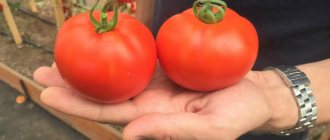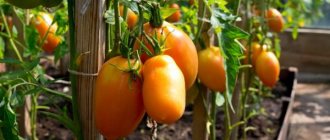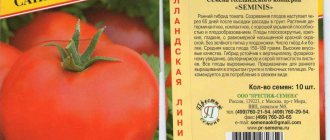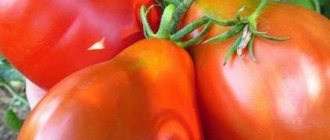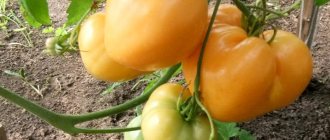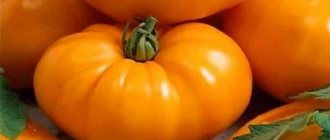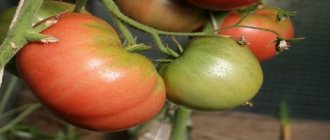Tomato Valentina is known to many gardeners in all regions of our country. And this is not surprising, because it was bred specifically for the Russian climate, which is often completely unpredictable. Frequent alternations between cool days and heavy rains or, conversely, severe drought are not scary for the variety - the tomato will withstand any weather test. But its main feature is its vitamin composition. The fruits are rich in vitamins C, K and B, proteins, fiber, organic acids, carotene and minerals.
Characteristics and description of the variety
The Valentina tomato variety was bred more than two decades ago by Russian breeders. Included in the State Register of Selection Achievements in 1998. Ideal for breeding in any climatic conditions of Russian regions, both in open and protected ground.
Distinctive features
Determinate type, non-standard, spreading, height 55-60 cm. Branching is weak, leaves are yellow-green. The inflorescences are simple, the first one is formed above the 6-7th leaf, the next ones every 1-2 leaves.
Reference ! The main difference between a non-standard plant and a standard one is the weak stem.
An early ripening species, 95-100 days pass from the emergence of seedlings to full ripening.
The yield is high, 3-4 kg are harvested from 1 seedling, provided that 6-7 plants are planted per 1 square meter. m. Fruiting is not extended, ripening occurs at the same time.
It is highly resistant to the main diseases of the nightshade family. Well adapted to short droughts.
The culture does not require pinching, but it is impossible to do without a garter, despite the short stature of the seedlings. The fruiting branches are strewn with ripe vegetables, so they cannot bear the weight of them.
Fruit characteristics
Average weight 80-90 g, oval shape, elongated, orange-red, rich color. The taste is sweet with a slight sourness, the flesh is juicy and meaty. There are 2 seed chambers, few seeds. The skin is thick, durable, and not prone to cracking.
The purpose of tomatoes is universal: they are used fresh for preparing a variety of dishes, used for winter preparations and processed into tomato products.
Ripe vegetables can be stored for several months and can withstand long-term transportation without losing their presentation.
The photo shows Valentina tomatoes.
Preparing the soil for seedlings
Properly prepared soil for seedlings is an important condition for the Valentina tomato (photo below) to produce a high yield. Light soils rich in nutrients and slightly acidic are suitable for tomatoes.
The soil should include leaf soil, peat and sand, everything is taken in equal proportions and mixed thoroughly. The resulting soil must be disinfected. To do this, you need to freeze it in the freezer, steam it in a water bath or bake it in the oven.
How to grow seedlings
Sowing seeds for seedlings begins 2 months before planting in the ground. Seed material must be prepared for planting in order to prevent a number of diseases and increase the quantitative indicator of fruiting.
Seed preparation
The grains are laid out on the table and carefully examined one by one for visible damage. Grains suitable for sowing must be light in color, without bends or defects. They are then placed in a saline solution for 10 minutes. Those seeds that have sunk to the bottom are washed with running water and disinfected in a weak solution of potassium permanganate for 20 minutes.
To improve germination, seeds are soaked in a growth stimulator for 10 hours. Swollen grains can be sown in the ground.
Reference ! In addition to specialized drugs, melt or ordinary boiled water can serve as a growth stimulator.
Container and soil
The soil is prepared from a mixture of garden soil, humus, peat and river sand. River sand is added as a leavening agent for lightness . Peat contains many useful substances necessary for the full growth and development of seedlings. Such nutritious and fertile soil will accelerate the emergence of seedlings.
The resulting mixture is disinfected by steaming in an oven at a temperature of 50°C for at least 15 minutes or spilled with a hot solution of manganese. Soil disinfection destroys pathogenic flora, which ensures healthy growth of seedlings throughout the entire period.
You can plant in a common wooden box or in a separate container. Fill the planting container halfway with the prepared soil, adding the remaining soil as the seedlings grow. This technique helps to constantly receive the required amount of nutrients. Small drainage holes are made in advance at the bottom of the containers to allow excess moisture to drain into them.
Sowing
Seeds are sown to a depth of 1.5-2 cm with a distance of 3 cm from each other. Cover with soil on top, level, compact and lightly moisten with warm, settled water using a spray bottle. The sown containers are covered with film, thereby creating a greenhouse effect and left in a dark and warm room at a temperature of 24-26°C until germination.
Growing and care
When shoots appear, the film is removed and the containers are moved to a well-lit place on the windowsill. The temperature is maintained at 24-25°C. Daylight hours for seedlings are at least 14 hours. If the plants do not have enough daylight, they are illuminated with phytolamps.
Water moderately along the edge of the nursery with warm, settled water using a regular tablespoon. The main thing is not to overwater the sprouts, as excess moisture will negatively affect the young roots. After watering, the soil is loosened superficially with a wooden stick.
When 2 true leaves appear, the seedlings dive and are planted in separate containers. If the seeds are sown in peat pots, the seedlings do not need picking. The picking procedure involves shortening the main root by one third. Picking promotes the growth of lateral roots, due to which the seedlings grow vigorously.
Reference ! Throughout the entire period, seedlings do not need feeding.
2-2.5 weeks before planting, the seedlings are hardened off by taking them outside for 1 hour at a temperature of 16°C. Gradually, the time spent outdoors is increased to 14 hours. Simultaneously with daytime hardening, the night temperature in the room is reduced to 12°C.
Features of caring for Valentina tomato
Determinate tomatoes are most often characterized by simple agricultural technology, and although their yield indicators are somewhat lower than those of indeterminate varieties, they deserve attention.
The seeds of the variety are sown for seedlings in March, pre-soaking them in special solutions for disinfection and stimulation of germination.
Disinfection: seeds are dipped in a pink solution of potassium permanganate for 15 minutes, then washed thoroughly.
To improve germination, increase immunity: soaking tomatoes in a solution of Epin, Energen, infusion of wood ash, aloe juice.
Then the seeds are germinated in a damp cloth or gauze and sown in prepared boxes.
ON A NOTE!
Germinating seeds speeds up the emergence of seedlings.
After the first shoots of tomatoes appear, the boxes are exposed to light, the room temperature is reduced to 18ºC, and kept in this mode for about 4-5 days.
Then the temperature should be 22ºC... 24ºC until the end of growing the seedlings. Diving is mandatory; it is carried out when the tomatoes have 2-3 true leaves. They are transplanted into separate pots, and after 10-12 days they are fed with complex fertilizers.
Planting of seedlings - in May, the exact days are determined taking into account the weather and climate of the region.
Planting tomatoes
In open ground they plant 4-5 plants per “square”; in shelters they give the bushes more free space - 3 bushes each.
You may be interested in:
The soil should warm up to 13ºC... 14ºC, the beds can first be covered with black film.
Agricultural technology
All techniques for caring for the Valentina tomato are standard, the list includes:
- watering;
- loosening the soil (can be replaced by mulching);
- weeding;
- application of fertilizers.
Water the tomatoes regularly, trying not to take long pauses. For plants in the beds, there is often enough moisture from precipitation, but if the summer is hot, you will have to water it abundantly.
The water should be warm and settled. Neglect of these rules leads to the appearance of diseases in tomatoes, and even such resistant varieties as Valentina can “catch” the infection. After watering, greenhouses must be ventilated; in hot weather, windows and doors are opened.
There should be no weeds around the tomato bushes that “take away” moisture and nutrients from the plants. Mulching gives good results, saving summer residents from tedious weeding and tedious loosening.
Mulch is prepared from cut grass, bark, rotted compost, humus, and peat. Sawdust can be used, but it must first be thoroughly scalded with boiling water and sprinkled with humus or soil.
Organic matter and mineral fertilizers are used for fertilizing - there is a wide choice. Each gardener decides for himself which fertilizers to use, based on his capabilities and desires. Some make do with only organic matter, avoiding the use of “chemicals” on the site. In this case, it is necessary that the fertilizing be balanced in composition, and that the plants receive not only nitrogen, but also phosphorus and potassium in the required quantity.
The first feeding is 18-21 days after planting the tomatoes in a permanent place. To stimulate the growth of plants and the root system, diluted infusions of mullein (1:10) and bird droppings (1:15) are used.
The second feeding is after about two weeks, when mullein is used, as well as an infusion of wood ash. Mineral fertilizers are suitable for complex fertilizers, for example, nitrophoska. During the period of fruit ripening, tomatoes are provided with potassium and phosphorus (wood ash, superphosphate, potassium sulfate).
Watering with an infusion of fermented herbs (nettle, yarrow, comfrey) gives good results; only such a rich “cocktail” must be diluted with water 1:10.
During the season, tomatoes are fed 3-4 times, focusing on the condition of the plants. Do not forget about spraying on the leaves, for which compositions with boric acid, iodine, and potassium permanganate are suitable.
Diseases of this variety of tomatoes are not as dangerous as pests, so they dust the bushes with wood ash and plant fragrant herbs or flowers (marigolds, coriander) nearby. Typically, gardeners grow tomatoes in one greenhouse every year, without soil disinfection and crop rotation.
It is not possible to grow tomatoes in a new place every year, which means that green manure is sown in the fall, which disinfects the soil and enriches it with nutrients, replacing the top layer of soil. Such simple techniques will help protect tomatoes from the invasion of dangerous pests and ultimately save the harvest.
As preventive measures against diseases, they practice treating tomatoes with compounds containing garlic, ash, as well as Bordeaux mixture, the Barrier preparation. Spraying water with whey, as well as the drug Oxychom, helps against late blight.
Tomatoes are picked when they are green (technical ripeness) or already ripe on the bush. Harvesting unripe tomatoes allows you to increase the yield from the bush, especially since Valentina’s fruits ripen well indoors.
The Valentina tomato variety is recommended for cultivation in open ground or film shelters. The tomato is unpretentious, productive, suitable for all regions of the country.
Tomato Valentina is a non-standard determinate variety. They have limited growth and mature quickly. The bushes of such tomatoes are compact and have few stepsons. In open ground, such plants do not need to form a bush. But in greenhouses you should leave one stem.
In tomatoes, growth stops after the formation of an inflorescence, so a small shoot is left under the first one to continue growth. After the formation of two inflorescences and three leaves on it, it is pinched. The stems of the variety are reclining, so the bushes are tied to a wire with twine. These are the care features of the Valentina tomato.
The lower leaves begin to be torn off a month after the seedlings are planted in a permanent place. It is best to break off the leaves in the morning when the sun is shining. There should not be any of them below the first inflorescence when the fruits ripen on it.
The remaining leaves continue to be removed until the third inflorescence. This design of the bushes allows the fruits to ripen quickly and increases air exchange. In August, the main stem is pinched and all new shoots are removed.
How to grow tomatoes
After 2 months, the seedlings are ready for planting in the ground. By this time, it has 5-7 true leaves, a strong stem and a fully developed root system.
Landing
The soil is prepared in the fall, dug up and fertilized with humus. In the spring they dig again with the addition of mineral fertilizers. For planting, prepare holes 15-20 cm deep at the bottom of which a little sawdust or wood ash is placed.
Replant on a cloudy day or in the evening, after sunset. The tomato is planted in the ground in which beets, herbs, garlic, cabbage or carrots previously grew. After these crops, the soil is not depleted, which is favorable for crops from the nightshade family.
Planting pattern: 40 cm – distance between seedlings, 60 cm – row spacing. For 1 sq. m place 6 – 7 plants. They are planted in a checkerboard pattern, which helps to ventilate each plant and receive the required amount of light. After transplantation, the bushes are not watered or fed for 2 weeks. During this time they adapt to new conditions.
Tomato Valentina. SeDeK
Further care for the Valentina tomato
Regular watering is established no more than 2 times a week. Water with warm water, using 4-5 liters for each bush. During the formation of buds, the amount of watering is increased, watering every 3 days. After each watering, the beds are loosened, removing weeds and thereby destroying a favorable substrate for the development of fungal diseases.
Also, pests successfully multiply in weeds, which, moving to tomatoes, destroy both the leaves and the fruits themselves. To keep the beds moist longer, they are mulched with peat or straw.
Feed tomatoes once every 3 weeks. Before flowering, mineral fertilizers containing mainly nitrogen, which is necessary for the active growth of shoots, are used as fertilizing. Organics are also used, for example, urea solution.
During the formation of the ovaries, they are fed with potassium-phosphorus fertilizers for faster fruit filling. 35 g of superphosphate and potassium salts are dissolved in 10 liters of water.
Reference ! All fertilizing is applied after watering, at the root of the plants.
Features of care and possible difficulties
Culture does not require stepsoning. Moreover, experienced gardeners claim that pinching this variety leads to a decrease in yield.
Bushes require obligatory garter not only of the stem, but also of the fruit-bearing branches. To do this, wooden stakes or metal rods are installed next to each seedling, to which the plants are fixed. If the stem is tied to a support immediately after transplantation, the trunk will form smooth and strong. As the branches develop, they must also be fixed, otherwise they will creep along the ground from the weight of ripe vegetables. In addition, tied branches make harvesting easier.
Diseases and pests
The most dangerous fungal diseases for tomatoes are late blight, gray rot and fusarium leaf wilt. The risk of disease increases with prolonged rains and constant humidity in the beds due to non-compliance with a moderate watering regime.
For preventive purposes, plants are treated with contact fungicides “Fitosporin” and “Hom”. You can also spray plants with infusions of various herbs, for example: nettle, plantain, onion peel decoction.
Treating plants with such infusions protects the crop from many pests that do not like strong odors. These include: whitefly, spider mite, mole cricket. To scare away the mole cricket that lives underground, crushed cloves of garlic are dug into the beds.
The surest preventative method is to inspect the bushes for pests and changes. In this way, pathology can be prevented almost immediately, which will preserve the health of the plants.
Diseases and pests
Despite the high resistance to tomato diseases, the plant can still become infected if the rules of agricultural technology are not followed. Let's look at diseases and how to treat them:
- Late blight is a fungal disease. It is harmful and if it is not treated in time, you can lose one or more bushes of the plant. This disease has a damaging effect on those organs of tomatoes that are not in the ground, that is, on everything except the root system. Darkening and plaque appear on the plant and, as a result, rotting of such areas occurs. To avoid such a disease, it is necessary to carry out prevention by spraying with pesticides.
- Anthracnose of tomato. There are two types of this disease. In leaf form, the upper leaves wilt and the upper part of the central stem is exposed. The second type is damage to the fetus itself; it becomes covered with dark spots. For prevention, drugs based on Bacillus subtilis are used.
- Gray rot is common in many regions and deprives vegetable growers of more than half of their harvest. The fungal disease covers the entire area of the stem, provokes tissue necrosis, and causes a white-gray coating. The result is that the plant withers and dies. The infection is transmitted not only among this culture, but also from others. For such a disease, agrotechnical and chemical treatment measures are used.
- Powdery mildew develops most quickly in glass greenhouses. The pathogenic powdery mildew fungus, when accessed to a crop, affects almost the entire volume of the crop. It has several types of pathogens. One of these contributes to the formation of a white coating on the leaves. Another type appears as yellow spots on the upper parts of the leaves, after which a white powdery coating appears over the entire area of the leaf. Powdery mildew spreads faster when the humidity level is low and the temperature is low and the plant is rarely watered. To cure any type of fungus of this disease, sodium humate 0.1 percent is required.
- Stem cancer practically does not spread in glass greenhouses and open beds. But in film structures it develops at lightning speed and if the infection gets there, all the plants will die. The disease is expressed mainly on the stems. Brown, depressed spots appear at their bases, from which liquid oozes. Sometimes such spots may also appear on the “Valentina” fruits, followed by the process of mummification of the fruits and stems. Favorable conditions for the development of the disease are coolness, humidity and low temperature. When the plant is disposed of, the infection will remain on the seeds or plant debris. Growth regulators are used for treatment. People commonly treat stains on fruits with chalk paste.
- Septoria - if affected by this disease, you can lose more than half of the crop. This disease most often affects old leaves that are closer to the ground. As a result, these leaves begin to become covered with various spots, become deformed and subsequently dry out. Favorable temperature for the progression of the disease is from 15 to 27 degrees with high air humidity. But the “Valentina” variety has a gene that is resistant to this disease.
The nuances of breeding in open ground and in a greenhouse
Tomato leaves have a yellow-green color, but this does not mean that the plant is unhealthy. This color is quite normal for this variety and does not imply any health measures.
Pinching shoots leads to a decrease in the quantitative indicator of fruiting; it is not recommended to pick off leaves even during the seedling period. The only leaves to be removed are the lowest ones, as if they come into contact with wet beds they can rot and cause various infections.
When transplanting into open ground in regions with a temperate climate, do not forget about the danger of an unexpected drop in temperature. For such cases, keep covering material on hand so that, if necessary, you can use it immediately, thereby preserving the plants. The crop is also covered in case of prolonged rains.
Closed structures are ventilated daily. The influx of fresh air destroys the usual habitat of pathogenic microorganisms and many pests. In addition, ventilation regulates the humidity level, preventing it from rising and creating favorable conditions for the development of diseases.
Description of the Tais tomato and recommendations for propagating the plant in seedlings
The Tais tomato was included in the Russian State Register of Vegetable Crops in 2010. It belongs to the group of varieties with early ripening. Breeders recommend growing Thais tomatoes outdoors in the southern regions of the country. When planting in the middle zone, a film greenhouse (without heating) or a greenhouse is required. In Siberia and other northern regions, Tais is bred in greenhouse complexes with good heating. Tomatoes are consumed fresh, canned, and made into juices, ketchups, and pastes.
Tomato technical data
The characteristics and description of the variety are as follows:
- The first harvest of fruits is harvested 110-120 days after emergence.
- Thais tomatoes grow on a bush whose height ranges from 80 to 100 cm. The stems of the plant produce an average number of leaves, colored in dark shades of green. The leaf blades are medium in size.
- The plant has a simple type of inflorescence.
- The shape of the fruit resembles a ball, flattened at the bottom and top. A faint ribbing is visible on the side surface of the berries. Ripe fruits are colored red.
- The weight of the berries ranges from 0.2 to 0.22 kg. The pulp has medium density. When you cut the berry, you can see from 4 to 6 seed chambers.
Those who planted the described variety note that Thais has high productivity. From 1 m² of bed you get from 6 to 7 kg of fruit. Feedback from farmers shows that tomato tolerates sudden changes in temperature well. The plant can withstand cold, but there is no need to experiment with this property of the tomato, otherwise you may lose the entire harvest.
That part of the gardeners who planted Tais on their plot claims that the variety is unpretentious in care. Tomato is resistant to many diseases that are dangerous for nightshade crops.
Gardeners note that the fruits of the described plant are stored for 20-25 days in a cool room, without deterioration in taste. Trading and manufacturing companies buy large quantities of Tais from the population. The tomato can easily withstand transportation over long distances.
Obtaining seedlings and caring for tomatoes
Seeds are purchased in specialized stores. It is recommended to disinfect them with a solution of potassium permanganate or hydrogen peroxide. This preventive measure increases seed germination and eliminates the risk of fungal infection.
To sow seeds, you need to purchase complex soil or make the soil yourself, taking equal parts of garden soil, sand and peat. You will also need containers, for example, plastic boxes with holes. Soil is poured into them, treated with potassium permanganate, and then the seeds are placed to a depth of 10 to 20 mm.
Regular watering with warm water is required. In the room where the container with seeds is located, the temperature is maintained at least 21°C.
In a week the first shoots will appear. When this happens, the boxes with seedlings are placed under fluorescent lamps or in a well-lit place.
When 1-2 leaves appear on the sprouts, the plants are planted, and after 2 months they can be transferred to permanent soil. Before this, the sprouts are hardened for 7-10 days.
Seedlings are planted in a 0.5x0.5 m format. To do this, the soil in the garden bed is loosened and organic and nitrogen fertilizers are added to it. Then the bushes are planted and watered with a small amount of water.
Although the plant is easy to care for, it is recommended to adhere to certain rules of agricultural technology, otherwise you may lose the entire harvest. Water the bushes regularly, 1-2 times a week. This operation is performed using a watering can and warm water. Watering time is early morning or late evening.
It is necessary to loosen the soil under the bushes every 6-7 days. Weeding is recommended to be done 2 times a week. The plants are fed with nitrogen and potassium fertilizers during growth. After flowering begins, potassium and organic mixtures are used. After the first fruits appear, fertilize with complex fertilizers containing phosphorus and potassium.
To protect tomato bushes from garden pests, various chemicals or folk remedies are used, for example, copper sulfate or soap solution. Slugs are repelled by adding ash flour to the soil near the roots of the tomato.
Harvesting and application
Ripe vegetables begin to be collected in July-August. Fruiting is not extended, ripening is almost simultaneous, which significantly simplifies harvesting.
The purpose is universal: smaller tomatoes are used for whole-fruit canning, barrel pickling and marinades. Larger vegetables are processed into tomato products, from which excellent juices, pastes, adjika, ketchups and lecho are obtained.
Tomatoes are also ideal in any fresh dishes: summer salads, hot and vegetable stews, purees, they are used in a variety of snacks and sandwiches. Also used in baking with meat and for pizza.
Ripe vegetables are stored for several weeks and even months without loss of memory and can withstand long-term transportation, perfectly maintaining their presentation.
Health benefits of this variety
Tomato contains a number of vitamins and substances valuable for the body. He has:
- vitamins B, C, K;
- cellulose;
- natural saccharides;
- proteins;
- carotene;
- a number of minerals;
- organic acids;
- lipcoin;
- serotonin;
- pectin.
The fruits retain their value even when boiled, fried or canned. They improve metabolism, fight bad cholesterol in the blood and generally have a beneficial effect on health.
Advantages and disadvantages
The overview of this section will summarize all the positive properties of the culture and note some of the disadvantages. The benefits include:
- drought resistance;
- early ripening;
- friendly return:
- unpretentious care;
- does not require pinching;
- high fruiting rate;
- possibility of breeding in any region;
- immunity to diseases;
- excellent taste of fruits;
- universal purpose;
- long storage;
- long transportations.
The disadvantages include the mandatory staking of short plants, but this is a common procedure with which all gardeners are familiar.
Growing tomatoes
The description that comes with each package of Valentina seeds recommends sowing tomatoes for seedlings at the end of March. A loose substrate for tomatoes and peppers, available at any gardening store, is suitable for sowing.
This variety is not a hybrid, therefore, in case of successful cultivation, the seed for the next season should be collected from its own harvest.
The first shoots appear within 5-7 days if the air temperature is constantly maintained at 23-25°. You can pick plants into separate containers from a common container when two full-fledged leaves appear.
Seedlings are planted 2 months after sowing. It is important to wait until the young plants are no longer threatened by returning frost or chilly soil.
Everyone who has previously planted the Valentina variety chooses the 40x50 cm scheme; it is ideal for small bushes that do not have spreading green mass.
If the plant does not need pinching, then tying it to the supports will be needed almost immediately after moving the seedlings into the ground.
Farmer reviews
Judging by the characteristics and reviews of those who planted the crop in their gardens, for most gardeners this tomato is a kind of lifesaver that will not fail under any circumstances.
Vera, Magnitogorsk: “I was very impressed by the photos, so I decided to plant this tomato. The seeds sprouted quickly and the seedlings were not sick. Grown in open ground. Even with minimal care, the variety pleased with its yield. Each bush ripened 6-7 fruits. I used it for pickling, but they are also good fresh. I’ll definitely plant it again.”
Peter, Nizhny Novgorod: “Excellent view for open ground. I always plant low-growing tomatoes in a garden bed without shelter. The bushes do not stretch and produce good offspring. Vegetables of unusual elongated shape. The pulp is juicy. The taste is pleasant, you can add these tomatoes to salads. The variety is also suitable for preservation. I didn’t overshoot the plants, the yield was at the same level.”
How is the variety useful?
The taste of Valentina tomatoes is a good addition to salads. But it’s even better to cook from them:
- sauces and lecho;
- preservation of whole fruits;
- frying;
- canned salads
Advice : it is better to pick tomatoes of this variety early and leave them to ripen.
Valentina fruits are fleshy with a dense peel, so they produce high-quality juice and tomato paste.
Why are these tomatoes so beneficial to include in your diet? They are valued primarily for their high content:
- natural saccharides;
- vitamins C, B, K;
- proteins;
- fiber;
- organic acids;
- carotene;
- minerals;
- serotonin;
- lipcoin
Tomatoes do not lose their beneficial properties even after heat treatment. Eating them helps reduce cholesterol and normalize metabolism, improve mood, and increase the vitality of the body.
Low-growing, early, productive varieties of tomatoes, buy determinate tomato seeds - page 11
On page: 15 25 50 75 100
Default Name (A -> Z) Name (Z -> A) Price (ascending) Price (descending) (descending) (ascending) Model (A -> Z) Model (Z -> A)
Determinant, mid-early. Tomatoes are flat-round, pink, weighing 80-150 grams. Dense, crack-resistant, fleshy. Taste with sweetness. The purpose is universal. The bush is spreading, can be grown in 3-4 stems. The entire crop can be harvested in two approaches. 1 sachet – 5 seeds..
40.00 rub.
Determinant, 0.8 m. Early ripening. Red tomatoes, flat-round, large, 120-160 grams. Very tasty! Productivity is high even in unfavorable summers. A variety for open ground and low greenhouses. Included in the State Register of the Russian Federation in 1951. 1 bag - 10 seeds. ..
40.00 rub.
Determinant, up to 0.40 m. Standard. Early. Red tomatoes weighing 60-80 grams, scattered bush! Sweet! A great variety for beginners! Can be grown in pots on a windowsill or balcony. A completely undemanding variety, disease-resistant. 1 bag - 10 seeds. ..
40.00 rub.
Determinant, up to 0.6 m. Early. Tomatoes are red, cigar-shaped, up to 8 cm long, dense, fleshy, sweet. An excellent variety for canning. Harmonious ripening and yield of the harvest. Formation is minimal. Disease resistant. Productive for any growing conditions. Siberian selection. ..
40.00 rub.
40.00 rub.
40.00 rub.
50.00 rub.
Determinant, up to 0.7 m in any conditions. Early. The tomatoes are round, red, weight 160-180 grams, no small fruits. Fleshy, elastic, balanced rich taste with a predominance of sweetness. Universal purpose. The bush is spreading, it will need a garter or supports. Formation is minimal..
40.00 rub.
Determinant, up to 0.6 m, early. Tomatoes are round, red, up to 150 grams. Very dense and meaty, all 4-chambered. Rich, balanced taste. Suitable for growing in regions with unfavorable summers. Productivity is always high! For low greenhouses and open ground. 1 pa..
40.00 rub.
40.00 rub.
Determinant, bush height 0.6 m. The tomatoes are plum-shaped, red, very dense, fleshy and sweet, weighing 40-60 grams. All are 2-chamber, there is little liquid. Ripe ones do not crack or fall off. Brushes through a sheet or one after another. The length of the branches is up to 80 cm, but under load the bush will still not be tall..
40.00 rub.
Determinant, up to 0.6 m. Early. Tomatoes are round, red-orange, 80-150 grams. Meaty and juicy, elastic. With a small amount of acid in taste. The purpose is universal. Grow outdoors in cool regions by removing the lower foliage. Ripening in clusters is uniform, the whole harvest...
40.00 rub.
Determinant, 0.6-0.8 m. Early ripening. The fruits are red, plum-shaped with an elongated nose, weighing 60-80 grams. Very unusual appearance of tomatoes. Super productive variety, unpretentious and not painful. For accelerated ripening, the plant can be formed into 3-4 stems or the lower leaves can be removed..
40.00 rub.
40.00 rub.
Determinant, up to 0.6 m. Early. The tomatoes are bright crimson in color, flat-round in shape, weighing 100-200 grams, practically no small ones. A wonderful sweet salad variety. It tolerates cold weather well and bears fruit in cloudy and rainy weather. Highly productive! Frost-resistant variety bred Sar..
50.00 rub.
Planting and care
Tomato seeds are sown for seedlings 50-55 days before planting in a permanent place. They dive when the plant produces its second true leaf.
Pre-hardened seedlings are planted in the ground. It is necessary to fertilize the soil, add peat, manure, sand for looseness, and prepare pegs for tying.
Regular watering with warm water is required at least once a week, fertilizing with mineral and organic preparations, weed and pest control, and also hilling of bushes.
Origin of the “Valentina” tomato variety
Tomato Valentina has been on the State Register since 1998.
Its planting is allowed in any region of Russia. The variety is intended for open ground. It is recommended to grow it in garden plots and farms. The plant is of a determinate type, non-standard, spreading. The branching of the shoots is weak, the number of leaves is below average. The height of the bush is 55-60 cm. The leaves are medium-sized, slightly corrugated, typical for tomatoes, green-yellow in color, and have stipules.
The inflorescences are simple. The first bud appears above the 7th leaf. The next inflorescences are laid every 1-2 leaves. The peduncle has an articulation. Fruiting begins on the 97th day after seed germination.
Description of fruits
Description and photo of tomato Valentina:
- medium sizes;
- fleshy pulp;
- smooth thick skin;
- elongated oval shape;
- The color of unripe fruits is light green, becoming orange-red as they ripen;
- number of sockets – 2 pcs.;
- weight from 80 to 87 g.
The taste of Valentina tomatoes is rated at a high level. Of the total harvest volume, 95-97% of tomatoes have commercial properties. Fruiting is not extended, all fruits ripen at the same time.
Valentina tomatoes stand out among other varieties due to their characteristics. Gardeners especially value their productivity, universal use, and resistance to drought and disease.
The variety bears harvest in July-August. According to the description, Valentina tomatoes produce 12 kg of fruit per 1 sq. m landings. Up to 4 kg of tomatoes can be harvested from one bush. Tomatoes are planted in open areas. Planting under film cover is allowed. Yields are positively affected by the supply of water and minerals.
Tomato Valentina has universal application. The fruits are consumed fresh for snacks and salads. Tomatoes are suitable for whole-fruit canning; they do not become soft during heat treatment.
Tomato variety Valentina is resistant to major diseases. To protect plantings from fungal diseases, follow the rules of care and perform preventive spraying. Insecticides or folk remedies are used against insects.
Tomato Valentina deserves attention due to the following characteristics:
- drought resistance;
- friendly ripening of fruits;
- universal purpose of tomatoes;
- compact dimensions;
- do not require stepsoning;
- early fruiting.
A relative disadvantage of the Valentina tomato variety is the need for care. Tomatoes need watering, fertilizing, and tying up.
“Valentina” tomatoes were bred by Russian plant breeders at the Vavilov Institute. The variety is included in the State Register of the Russian Federation. The main purpose of tomatoes is to grow in unprotected soil and in greenhouse conditions.
Gardeners' opinion
Reviews from those who grew the Valentina variety of tomatoes are always positive. Anyone who once grew them wants to plant them again.
Lydia, 56 years old: I planted this variety for two years in a row. Very pleased with the taste and quality. All tomatoes ripened healthy. Our family are lovers of these small sweet fruits. And they taste even better marinated.
Ulyana, 46 years old: Tomatoes of the Valentina variety have simply extraordinary taste, meaty, sweet, neat. I planted it fresh for food. The salads are simply delicious. It was normal to reschedule while the family was on vacation. The harvest was good.
Valentina - tomatoes with amazing properties. They hardly get sick, store well, and have a rich tomato taste. They can be grown for sale and for fresh eating. Before planting this variety, you need to familiarize yourself with the characteristics of these tomatoes.
Review of hybrid reviews
Due to its positive qualities and ease of care, the variety has received numerous reviews from gardeners all over the country.
Marina Pavlovna writes: “I planted the tomato Valya f1, after reading the description in the store, for the first time five years ago. It was a cold year then, and there were bushes growing outside. I thought they would disappear, but no, all the plants grew poorly, but the bushes with tomatoes developed perfectly. As a result, I got an excellent harvest of delicious tomatoes. Since then, Valentina tomato bushes have always grown in my garden.”



